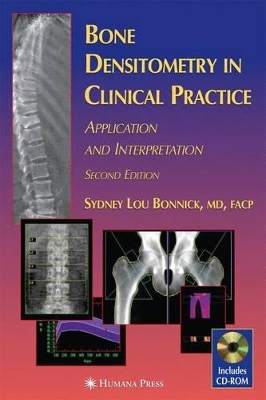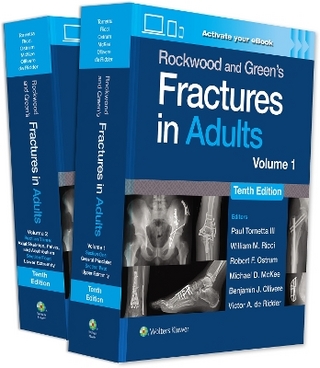
Bone Densitometry in Clinical Practice
Humana Press Inc.
978-1-58829-275-9 (ISBN)
- Titel erscheint in neuer Auflage
- Artikel merken
This fully updated and dramatically expanded edition will allow family physicians and specialists to fully understand not only what they need to do, but also why. Over half the book are discussions of the clinical guidelines for selecting patients for densitometry measurements. This book includes various questionnaires and indices that have been developed to help patients identify themselves as candidates for bone mass measurements, and specific densitometry applications of diagnosis, fracture risk prediction, and monitoring changes in bone density. Updated material includes an expanded review of the effects of diseases and drugs on bone density, new standardization formulas for the hip subregions and forearm, statistical devices necessary to 'test the test', and guidance on how to do a short-term precision study and apply the result to clinical practice. An accompanying CD-ROM contains a Precision Calculator, a Statistical Confidence Calculator for Measured Change in BMD, OST Nomograms, a Patient Risk Factor Questionnaire, and a CME review, which, if successfully completed, can lead to 30 hours of AMA Category I continuing education credit.
Chapter 1: Densitometry Techniques Plain Radiography in the Assessment of Bone Density. Qualitative Morphometry. Qualitative Spinal Morphometry. The Singh Index. Quantitative Morphometric Techniques. Calcar Femorale Thickness. Radiogrammetry. The Radiologic Osteoporosis Score. Radiographic Photodensitometry. Radiographic Absorptiometry. Photon Absorptiometry Techniques. Single-Photon Absorptiometry. Dual-Photon Absorptiometry. Dual-Energy X-Ray Absorptiometry. Peripheral DXA. Single-Energy X-Ray Absorptiometry. Quantitative Computed Tomography. Peripheral QCT. Quantitative Ultrasound Bone Densitometry. References. Chapter 2: Skeletal Anatomy in Densitometry Characterizing the Skeleton in Densitometry. The Axial and Appendicular Skeleton. The Weight-Bearing and Nonweight-Bearing Skeleton. The Central and Peripheral Skeleton. The Trabecular/Cortical Composition of the Skeleton. Forearm Composition. Vertebral Composition. Femoral Composition. All Sites. The Spine in Densitometry. Vertebral Anatomy. Artifacts in PA or AP Spine Densitometry. Vertebral Fractures. Degenerative Changes and Dystrophic Calcification. Effect of Osteophytes on BMD. Effect of Aortic Calcification on BMD. Effect of Facet Sclerosis on BMD. The Vertebral Rotation and PA Lumbar Spine Bone Density. Other Causes of Artifacts in PA and AP Lumbar Spine Studies. The Spine in the Lateral Projection. The Proximal Femur in Densitometry. Proximal Femur Anatomy. Effect of Rotation on BMD in the Proximal Femur. Effect of Leg Dominance on BMD in the Proximal Femur. Effect of Scoliosis, Osteoarthritis, Osteophytes, Surgery, and Fracture on BMD in the Proximal Femur. The Forearm in Densitometry. Nomenclature. Effect of Arm Dominance on Forearm BMD. Effect of Artifacts on BMD in the Forearm. The Metacarpals, Phalanges, and Calcaneus. Bone Physiology. Bone Growth, Modeling, and Remodeling. Bone Modeling. Bone Remodeling. The Basic Multicellular Unit in Bone Remodeling. References. Chapter 3: Statistics in Densitometry The Mean, Variance, and Standard Deviation. The Mean. The Variance and Standard Deviation. Coefficient of Variation. Standard Scores. Z-Scores. T-Scores. Standard Scores on Bone Density Reports. Measures of Risk. Prevalence and Incidence. Prevalence. Incidence. Absolute, Relative, and Attributable Risk. Absolute Risk. Relative Risk. Attributable Risk. Odds Ratios. Confidence Intervals. Accuracy and Precision. Accuracy. Precision. Types of Data. Quantitative Data. Qualitative or Categorical Data. Data and Variables. Correlation. Statistical Significance and the P Value. Regression Analysis. Statistical Evaluations of Diagnostic Tests. Sensitivity and Specificity. Likelihood Ratios. Receiver Operating Characteristic Curves. Regression to the Mean. References. Chapter 4: Quality Control Phantoms. The European Spine Phantom. The Bona Fide Spine Phantom. The Hologic Spine and Hip Phantoms. The Lunar Spine Phantom. Using the Phantom to Create Control Tables and Charts. Shewhart Rules and CUSUM Charts. Shewhart Rules. CUSUM Charts. Automated Quality Control Procedures. Replacing a Densitometer. References. Chapter 5: Bone Density Data: From DPA to DXA and Manufacturer to Manufacturer From DPA to DXA. Hologic DXA and Lunar DPA. Lunar DXA and Lunar DPA. Hologic DXA, Lunar DXA, and Lunar DPA. DXA: From Lunar to Hologic to Norland. Hologic DXA and Norland DXA. Lunar DXA and Hologic DXA. Standardization of Absolute BMD Results. Standardization of Central DXA Absolute BMD Values. Standardization of DXA BMD Results for the Femoral Neck, Trochanter, and Ward's Area. Standardization of Forearm DXA Results. The Utility of the sBMD. From DXA Machine to DXA Machine Within Manufacturers. From Pencil-Beam to Fan-Array DXA Data. Reference Databases. References. Chapter 6: The Effects of Age, Disease, Procedures, and Drugs on Bone Density Age-Related Changes in Bone Density. Bone Density in Children. Bone Density in Premenopausal Women. Dissimilar BMDs Between Skeletal Sites at Peak and Prior to Menopause. Bone Density in Perimenopausal Women. Dissimilar Spine and Femoral BMDs in Perimenopausal Women. Changes in Bone Density in Postmenopausal Women. Changes in Bone Density in Men. The Effect of Diseases and Procedures on Bone Density. Acromegaly. Ankylosing Spondylitis. Alcoholism. Amenorrhea. Hyperandrogenic Amenorrhea. Exercise-Induced Amenorrhea. Anorexia Nervosa. Cirrhosis. Cushing's Syndrome. Cystic Fibrosis. Diabetes. Insulin-Dependent Diabetes Mellitus. Noninsulin-Dependent Diabetes Mellitus (NIDDM). Ehlers-Danlos Syndrome. Estrogen Deficiency (Postmenopausal). Familial Dysautonomia. Gastrectomy. Type 1 Gaucher Disease. Gluten-Sensitive Enteropathy. Human Immunodeficiency Virus Infection. Hypercalciuria. Hyperparathyroidism. Hyperprolactinemia. Hyperthyroidism. Inflammatory Bowel Disease. Intravenous Drug Abuse. Klinefelter's Syndrome. Marfan's Syndrome. Mastocytosis. Multiple Myeloma. Multiple Sclerosis. Neurofibromatosis. Osteoarthritis. Paralysis. Hemiplegia. Paraplegia. Parkinson's Disease. Pregnancy and Lactation. Radiotherapy. Regional Migratory Osteoporosis. Renal Failure. Rheumatoid Arthritis. Thalassemia Major. Transient Osteoporosis of the Hip. Transplantation. Cardiac Transplantation. Liver Transplantation. Marrow Transplantation. Renal Transplantation. Weight Loss. Wilson Disease. The Effect of Drugs on Bone Density. Alendronate Sodium. Calcitriol. Calcium and Vitamin D. Corticosteroids. Oral Corticosteroids. Inhaled Corticosteroids. Estrogen/Hormone Replacement. Etidronate. GnRH Agonists. Heparin. Ipriflavone. Medroxyprogesterone Acetate. Nandrolone Decanoate. Raloxifene. Risedronate. Salmon Calcitonin. Sodium Fluoride. Tamoxifen. Teriparatide. Thyroid Hormone. Tibolone. Zoledronic Acid. References. Chapter 7: Selecting Patients for Bone Mass Measurements: Clinical Guidelines Clinical Guidelines. 1988 National Osteoporosis Foundation Guidelines. 1998 NOF Guidelines. 1996 Guidelines of the International Society for Clinical Densitometry. 1996 American Association of Clinical Endocrinologists' Guidelines. 2001 AACE Guidelines. Guidelines from the European Foundation for Osteoporosis and Bone Disease. 2002 ACOG Recommendations for Bone Density Screening for Osteoporosis. 2002 North American Menopause Society Recommendations. 2002 US Preventive Services Task Force Recommendations. Guidelines for Bone Density Testing in Men. 1999 World Health Organization Task Force Recommendations for Men and Women. How Do the Guidelines Compare? References. Chapter 8: Selecting Patients for Bone Mass Measurements: Self-Assessment Indices Simple Calculated Osteoporosis Risk Estimation. Osteoporosis Risk Assessment Instrument. The Study of Osteoporotic Fractures Simple Useful Risk Factor System. ABONE. The Osteoporosis Self-Assessment Tool. Weight Selection Criteria. The FRACTURE Index. Comparing the Performance of Self-Assessment Questionnaires. Summary. References. Chapter 9: Diagnosing Osteoporosis Guidelines of the Study Group of the WHO for the Diagnosis of Osteoporosis. The 1999 WHO and 2000 IOF Recommendations. The Clinical Dilemma. Peripheral Site T-Score Equivalents for the Diagnosis of Osteopenia and Osteoporosis. Changing the Definition of Osteoporosis. Diagnosing Osteoporosis in Men. Additional Considerations in Site Selection for Diagnosis. References. Chapter 10: Predicting Fracture Risk The Prevalence of Fracture at Different Levels of BMD. Fracture Risk Prediction. Site-Specific and Global Fracture Risk Prediction. Relative Risk Fracture Data. Global Fracture Relative Risk Data. Site-Specific Spine Fracture Relative Risk Data. Site-Specific Hip Fracture Relative Risk Data. Applying Relative Risk Data in Clinical Practice. Lifetime Risk of Fracture. 10-Year Fracture Probability. Remaining Lifetime Fracture Probability. The Fracture Threshold. Qualitative Risk Assessments. Predicting Fracture Risk in Men. Using Skeletal Morphometry from Densitometry to Predict Fracture Risk. Vertebral Morphometry and Fractures. The Relationship Between Prevalent Spine Fractures and Future Fracture Risk. Diagnosing Vertebral Fractures. Vertebral Fracture Assessment with Genant's Semiquantitative Technique. Quantitative Techniques. Performance Comparisons of Semiquantitative and Quantitative Techniques. Fan-Array Spine Imaging with DXA. Proximal Femur Morphometry. Hip Axis Length. The Femoral Neck-Shaft Angle. Femoral Neck Width. The Upper Femoral Neck. Hip Strength Analysis. Combining Clinical Risk Factors with BMD to Predict Fracture Risk. References. Chapter 11: Monitoring Changes in Bone Density The Concept of Precision. Performing a Precision Study. Short-Term Precision Studies. Mathematical Procedures Used to Calculate Precision. Step 1. Step 2. Long-Term Precision Studies. Applying the Precision Value to Serial Measurements. The Determination of LSC. A Case in Point. More Sophisticated Issues of Statistical Confidence for the Measured Change. Determining the Level of Confidence for Any Change and Precision. The Confidence Interval (CI) for the Change in BMD Between Two Measurements. The Importance of Precision. Which Skeletal Sites Should Be Used for Monitoring? How Frequently Should Measurements Be Repeated? Regression to the Mean and Monitoring. A Final Consideration. References. Chapter 12: Reporting Densitometry Elements of Densitometry Reports Requested by Primary Care Physicians. US Densitometry Center Reporting Practices. Recommendations from the Canadian Panel of the ISCD for Bone Density Reporting. Reporting the Diagnosis. Reporting Fracture Risk. Recommending Evaluations for Secondary Causes of Bone Loss. Treatment Recommendations. Recommending a Follow-Up Densitometry Study. Assessment of Risk Factors. Reporting Serial Studies. The Challenge in Reporting Densitometry Results. References. Chapter 13: FDA-Approved Densitometry Devices Computer-Enhanced Radiogrammetry. Sectra Osteoporosis Package IDS5 . Workstation Clinical Application. Computer-Enhanced Radiographic Absorptiometry. Automated OsteoGram(R). MetriScan . Central X-Ray Densitometers. Delphi . Discovery . DPX-IQ . DPX MD . DPX MD+ . DPX-NT . Excell Excell plus. EXPERT(R)-XL. Prodigy . QDR(R) 4500 A. QDR(R) 4500 C. QDR(R) 4500 SL. QDR(R) 4500 W. XR-46 . Peripheral X-Ray Densitometers. accuDEXA . Apollo . DexaCare(R) G4. DTX-200 DexaCare(R). pDEXA(R). PIXI(R) (Peripheral Instantaneous X-Ray Imager). XCT 2000 . Ultrasound Bone Densitometers. Achilles+ . Achilles Express . Achilles InSight . DTU-one UltraSure(R). McCue C.U.B.A.Clinical (Contact Ultrasound Bone Analyzer). Omnisense 7000S Ultrasound Bone Sonometer. QUS-2(R) Calcaneal Ultrasonometer. Sahara Clinical Bone Sonometer(R). Appendix I: Contacts for Bone Densitometry Manufacturers and Organizations of Interest. Appendix II: Conversion Formulas. Appendix III: Formulas and Tables Used in Serial Bone Density Measurements. Appendix IV: World Health Organization Criteria for the Diagnosis of Osteoporosis Based on the Measurement of Bone Density. Appendix V: Recent Guidelines for Bone Density Testing. Appendix VI: Bone Mass Measurement Act of 1997. Appendix VII: CPT Codes for Bone Densitometry. Appendix VIII: 2002 Medicare Reimbursement Rates. Appendix IX: NHANES III Proximal Femur Reference Data. Appendix X: Norland DXA Reference Data. Appendix XI: Hologic DXA Reference Data. Appendix XII: Lunar DXA Reference Data. Appendix XIII: Densitometry Patient Questionnaire. Appendix XIV: The CD-ROM Companion. Index
| Erscheint lt. Verlag | 17.9.2003 |
|---|---|
| Reihe/Serie | Current Clinical Practice |
| Zusatzinfo | 114 black & white illustrations, 114 black & white line drawings |
| Verlagsort | Totowa, NJ |
| Sprache | englisch |
| Maße | 178 x 254 mm |
| Gewicht | 2 g |
| Themenwelt | Medizinische Fachgebiete ► Chirurgie ► Unfallchirurgie / Orthopädie |
| ISBN-10 | 1-58829-275-4 / 1588292754 |
| ISBN-13 | 978-1-58829-275-9 / 9781588292759 |
| Zustand | Neuware |
| Haben Sie eine Frage zum Produkt? |
aus dem Bereich

